A musical Little Women brings Jo’s lurid imagination to life
By Joyce Morgan, Daniel Herborn, Bernard Zuel, Chantal Nguyen and Harriet Cunningham
THEATRE
LITTLE WOMEN
★★★½
Hayes Theatre, July 16 (Until August 11)
Reviewed by Harriet Cunningham
Remember Little Women? The book about the four sisters – the nice one, the nasty one, the one who dies and Jo – beloved of school reading lists and Christmas movie nights. Could it really work as a musical?
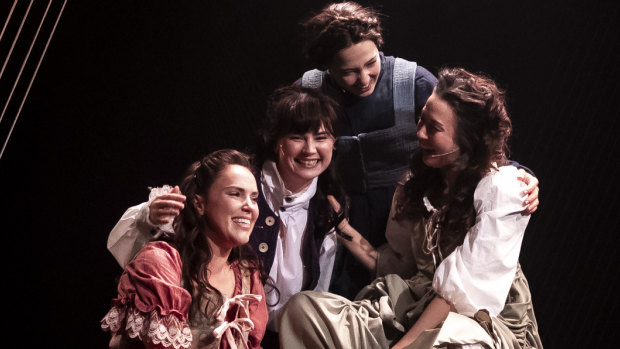
Madeleine Betts, Shannen Alyce Quan, Molly Bugeja and Kaori Maeda-Judge in Little Women at the Hayes Theatre.Credit: Grant Leslie Photography
A new production of Jason Howland’s (music) and Mindi Dickstein’s (lyrics) 2005 musical Little Women dismisses any initial concerns about how such a wholesome story will fare in a genre so poised to laugh at itself. Allan Knee’s book brings an impeccable logic, casting Jo’s writing transformation – from schlock horror hack into autobiographical novelist – as a framework to contain the rangy story.
This also creates an opportunity to bring Jo’s lurid imagination to life as a riotous play-within-a-play where music theatre’s niggling undercurrent of sexual innuendo, emotional excess and self-parody gets glorious free rein. With this creative outlet, the delicate business of growing up can play out in meticulous and moving detail.
Shannen Alyce Quan plays indefatigable Jo, the storyteller who doesn’t realise that they are, in fact, the story. With a rangy voice, impressive stamina and a magnetic fire in her eyes, she’s the star of the show, but they have strong competition from everyone else in the ensemble.
This includes an assured Emily Cascarino as Marmee, an adorably dour Tyran Stig as Professor Bhaer and newcomer Molly Bugeja, who brings a compelling inner glow to shadowy Beth. Tisha Kelemen makes a delightful debut as Aunt March, and Lawrence Hawkins, as Laurie, is a loveable foil to the young Jo.
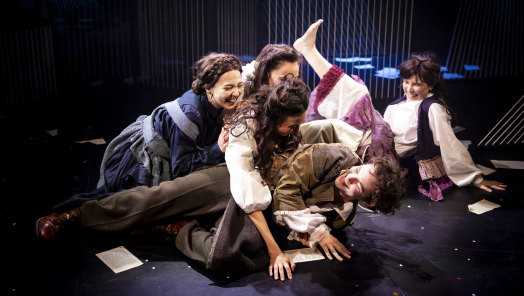
Molly Bugeja, Kaori Maeda-Judge, Madeleine Betts, Lawrence Hawkins and Shannen Alyce Quan in Little Women.Credit: Grant Leslie Photography
Director-choreographer Amy Campbell wrangles all this youthful energy into a tight ensemble that exploits every corner of the playing space. Tanwee Shrestha’s set is ingenious in its simplicity: a series of floor to ceiling parallel lines begin as a shorthand for dusty rays of sunlight through attic windows then, with artful help from Peter Rubie’s lighting, become the blank page for Jo’s vivid imagination.
On this simple canvas, Lily Mateljan’s costumes really pop – a grand parade of eccentric, homespun but lovingly detailed creations. Indeed, the costumes feel like a touchstone for the show, full of rough edges that you mostly forgive because they are so genuinely charming.
The exception is the flawed sound on stage and in the orchestra, which, on opening night, took the shine off a winning production.
THEATRE
SWIM
★★★½
Carriageworks, July 13 (Until July 27)
Reviewed by Joyce Morgan
The figure on the edge of the swimming pool is young, gender-fluid and Blak. “Why did I stop swimming? How can I get flowing again?” they ask.
The answers entail a deep dive into the murky waters of abuse, colonialism, dispossession and identity. It also entails a lyrical meditation on connection, healing and memory.

A play that punctures the myth of the public pool as a welcoming place on a hot day: Dani Sib.Credit: Louise Kennerley
This is the first play by award-winning Mununjali poet and writer Ellen van Neerven. In the past decade van Neerven, who is queer and non-binary, has emerged as a significant voice through poetry, fiction and memoir.
Most recently this includes Personal Score, which examines sport’s troubled relationship with race, gender and sexuality – concerns that are equally evident in Swim.
The popular image of the public pool is of a place that welcomes all on a hot summer’s day. This punctures that myth.
E (Dani Sib) has returned to the pool, sports bag in hand, beach towel around the neck, to put a toe into the water they once loved. But first they must navigate the women’s change room – overflowing with white naked flesh, pointed looks and cruel comments: “Isn’t that a bloke?”
The racist legacy of public Australian swimming pools quickly surfaces, as E notes: “It wasn’t too long ago they wouldn’t let you swim.” Not if you were black. E doesn’t elaborate, but it’s impossible not to think of Moree Pool and how Charles Perkins, with a group of Indigenous kids, challenged their exclusion in 1965.
This play began as a series of poems, and that genesis is apparent in the lyrical language and meditative tone. Indeed, it feels more like a staged poem than a fully realised drama.
The play shifts between present and memory as E revisits their early years as a competitive swimmer, muses on their fluid identity and the legacy of colonialism, which have left them searching for a place on stolen land.
At times, these transitions are so porous it’s unclear where in the story we are. We rewind to E’s infancy and meet Aunty, who taught them to swim. Aunty is E’s cheerleader whose unqualified love sustains E through the most troubled waters.
And there are treacherous waters to navigate as the once medal-winning young swimmer encounters a coach who grooms, abuses and almost destroys E.
For any director, given that some scenes place E underwater, realising the play presents challenges. Andrea James’ satisfying solution is to use video projections with a voiceover for these.
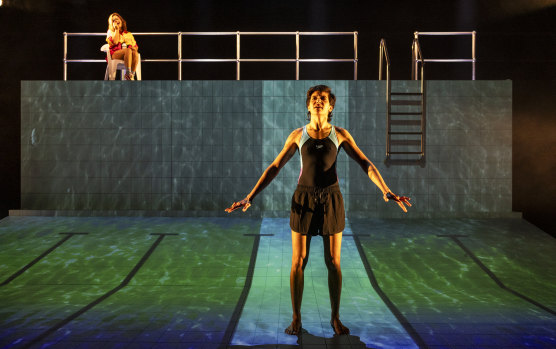
The set is a vast white tiled swimming pool onto which are projected images: Swim.Credit: Brett Boardman
Video (designer Samuel James) is a vital element of this production. The set (Romanie Harper) is a vast white-tiled swimming pool onto which are projected images, including of water and, at one point, multiple Es, suggesting infinite identities.
James has leavened a tale of shocking abuse by bringing out the humour in the piece. E’s flirtation and budding romance with the pool attendant Samena was a fine counterpoint, bringing levity as the pair sparked off each other.
With such a beautifully poetic text, there were occasions when lingering over key lines would have produced greater impact over this taut 75 minutes.
As the main character, non-binary Sib has created a multi-layered athletic E, bringing a mix of defiance, resilience and humour. The play is almost a one-person show and Sib’s energetic performance commanded attention throughout.
Sandy Greenwood, in several smaller roles, brought strength and dignity to Aunty. Combining warmth and fine comic timing, she excelled as the cheeky, playful Samena.
This is Griffin Theatre Company’s first show at Carriageworks while its Kings Cross home is renovated. It utilises well its larger temporary performing space with this imaginative production that plunges headlong into the politics of the pool.
COMEDY
MARIA BAMFORD
★★★★
Enmore Theatre, July 12
Reviewed by Daniel Herborn
“I’m pretty good at whatever it is I do, but let’s not try to define it,” Maria Bamford tells an adoring Sydney crowd. That seems as apt a description as any of Bamford’s idiosyncratic approach to stand-up; tonight’s set is as consistently hilarious as it is eccentric.

A set that pinballs gleefully from one comic idea to the next: Maria Bamford.
Covering some of the same territory as her singular memoir Sure, I’ll Join Your Cult, the 53-year-old Bamford’s set pinballs gleefully from one comic idea to the next, often touching on her experiences living with mental ill health and her penchant for joining self-help groups and connecting with the “stupid angels” she finds there.
Another recurring theme is her relationship with money – her early career struggles to earn it, her frustrations with entertainment industry machinations (including a running battle with a Hollywood figure anonymised as McDonaldland character Grimace) and her time in a Debtors Anonymous club. She’s unusually transparent and principled about her finances. She even pays an audience member for participating in some brief crowd work.
The Lady Dynamite star never signposts her stories or spends much time on a set-up; she simply races off on a train of thought and dares you to keep up.
Any given anecdote often involves several dramatic but deftly handled changes of tone, with Bamford uncannily dipping in and out of her array of voices, veering off on surreal tangents and exploring thought bubbles both dark and deeply silly.
There’s something stirring amid all the laughter. Bamford is every bit the defiant outsider, and she elevates her winding stories of surviving life’s setbacks and oddities with zany physicality. She doesn’t just stalk the stage, but sashays, rolls, hops and even mock-faints across it.
You can see the influence of Bamford’s uber-creative, kaleidoscopic comedy everywhere, but decades into her career, there’s still no one quite like her.
MUSIC
VOLUME FESTIVAL: TKAY MAIDZA
★★½
The Tank, Art Gallery Of NSW, July 13
Reviewed by Bernard Zuel
Location, location, location is a property mantra not a musical one as, theoretically, sonics rather than visuals should be the priority. But as anyone who has seen a show at the Opera House forecourt will tell you, many artists and audiences will accept less on the sound/comfort front when the trade-off is a view, a backdrop and a chance to say, “I was there”.
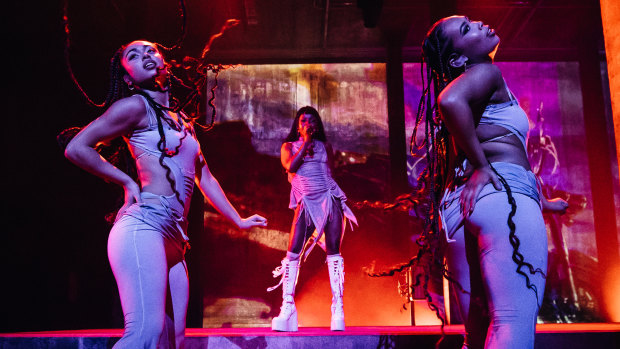
Tkay Maidza.Credit: Jordan Munns /Art Gallery of New South Wales
The Tank, the renovated former oil storage space beneath the new wing of the Art Gallery of NSW, is a location like no other in this city, presenting an opportunity and a problem for artists like Tkay Maidza whose scope has always been beyond the quotidian presentations of everyday bands. So far, though, it’s not clear yet which of opportunity/problem will prevail here.
First, it is not a music space: too echoey and too diffused; not loud enough to be physically imposing but too murkily loud for separation and clarity. Lyrics were mostly indistinct and between-song chat was rendered indecipherable, with the pillars making uninterrupted viewing impossible. Reviewing this musically makes little sense.
But it is a stunning event space: cavernous and evocative in pockets of dark and light; endless rough, narrow pillars that invite tactile contact; the feel of an excavated ruin with a faint smell of something old and lingering that is probably oil but hits you like dustiness overlaid on rust.
As a statement room, it demands first presence and then presentation. The charismatic Maidza has the presence immediately but the presentation never really came to grips with the demands. Back screen projections were abstract and elliptical to begin with (later, some of her videos were excerpted) but not imposing enough, while in front of them Maidza was fairly static and not served particularly well by fixed up-lights, though the side spots created shadows and some contraspace.
When two dancers joined her, the show became physical, expanding across the performance area, movement within the half-light energising the room. This was when the potential for more was most obvious. Given she is known for visually striking shows, confining Maidza to a narrow and not overly wide stage, shorn of any dressing or accoutrements, undersold her and underdressed the space.
Some of this was addressed when the walls around the room had visuals projected on them, enclosing us and pulling us more into the show. Some of the pressure on her as the sole focus was relieved and connection beyond the front rows of the crowd (who were, admirably, loudly supportive) was improved.
But it was not enough really when the opportunity was there for a runway from the stage out into the room; a secondary performance or display spot away from the main stage; more bodies and, definitely, more movement.
In other words, more recognition of location, location, location.
DANCE
CLUB ORIGAMI
★★★★
Neilson Studio at Sydney Dance Company, July 10 (Until July 20)
Reviewed by Chantal Nguyen (with Angus and Lachlan Mascarenhas)
My co-reviewer Angus (aged five) observes my other co-reviewer, his brother Lachlan (aged seven), kick off his shoes for Club Origami, Sydney Dance Company’s first season for the five-and-unders.
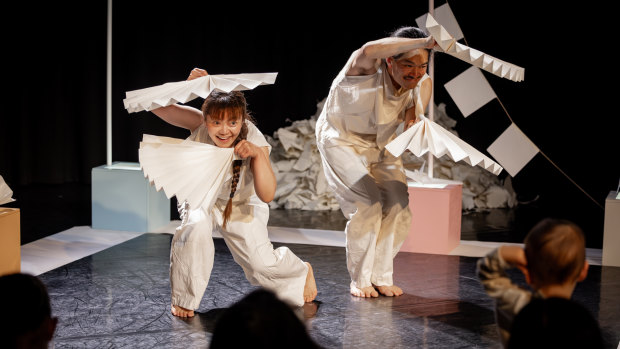
In Club Origami, Makiko Aoyama, left, and Takeshi Matsumoto, create an imaginary world of paper animals and quirky shapes.Credit: Jacquie Manning
It features the British-Asian dance collective Seven Circles, founded by choreographer and dance therapist Takeshi Matsumoto, known for his dance therapy initiatives with children, refugees, natural disaster victims and people with disabilities. Club Origami promises immersive paper-based fun: “Rip, fold and scrumple!” reads its website.
The kids press towards the doors, where Matsumoto and co-creator Makiko Aoyama hand out white paper squares. They are dressed like origami themselves – white costumes with soft, papery folds. Gus enthusiastically shapes his square into a replica of a giant whistle. Lachy, with his extra two years of fine motor skill development, produces a diligently straight-edged origami piece.
Older than the target audience, Lachy is here because of school holidays – he benevolently tolerates the babies crawling around him. Matsumoto and Aoyama receive the kids’ creations, then everyone piles around the stage where co-creator Robert Howat stands at a xylophone synthesiser, producing ribbons of shimmering chords.
What follows is 45 minutes of gentle, danced whimsy. It will delight any fan of a particular Japanese aesthetic: thoughtful, clean and playful. Matsumoto and Aoyama create an imaginary world of paper animals and quirky shapes – origami penguins, giant fans and a hat that is possibly a cat. They bring out the kids’ origami and replicate the shapes with their bodies.
Gus’s whistle inspires a particularly long improvised dance sequence. Exclamations of recognition abound. “I thought ‘Oh cool! My one! I’m part of the performance!’” Lachy explains.
Some children grow fidgety – until Aoyama runs out with a glowing light, like a firefly. Contention breaks out among the three- to five-year-old group. Is it a fire? No, it’s a light bulb!
Club Origami crescendos as Matsumoto wraps Aoyama in reams of rolled paper, lifting her onto his shoulders to morph into a giant paper monster. She dives headfirst into a mountain of torn paper. The audience gasps. Then they’re invited to join – shrieks of delight ensue.
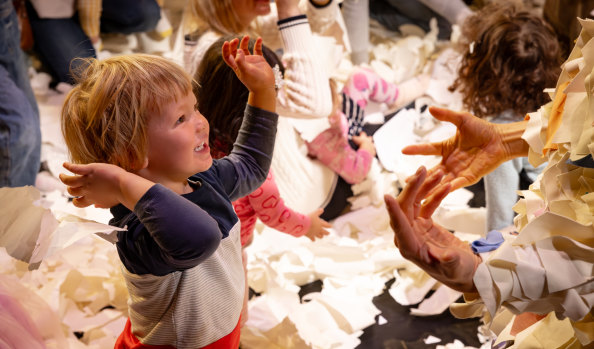
Club Origami found an appreciative young audience.Credit: Jacquie Manning
Gus and Lachy’s dad, Viren, notes it’s a diverse age group to entertain. But observing the audience rolling happily in the papery snowstorm, he nods approvingly. “This is the universal,” he says. “Ripping stuff up and throwing it around. You can’t go wrong.”
Lachy squeals “I’m in heaven here!” as he runs past.
CLASSICAL MUSIC
Sydney Symphony Orchestra: Saint-Saëns’ Organ Symphony
★★★½
Opera House Concert Hall, July 10
Reviewed by Harriet Cunningham
The grand organ of the Sydney Opera House Concert Hall is very patient. It waits its turn, the serried ranks of silver pipes which line the back of the hall – sometimes silent for years, just waiting, counting bars rest, until it is time. Last night French organist Olivier Latry woke the sleeping giant.
The giant was grumpy in the opening of Poulenc’s Organ Concerto, which lurches from a stern Bach-like harmony to a scrunch of dissonance, but Latry soon charmed the beast. Under the baton of Stéphane Denève, the concerto unfolded in all its odd glory, bouncing between celestial calm, stentorian dread and fairground antics.
Latry’s selection of voices for the concerto leaned into the dramatic contrasts, enjoying sudden mood changes and unapologetically blunt outbursts. Against this mercurial backdrop the strings of the Sydney Symphony Orchestra, led by associate concertmaster Harry Bennetts, shone through with their warm and consistent ensemble sound. As an encore, Latry raced against himself in a breathless scramble through Bach’s E major Partita. He won.
Camille Saint-Saëns’ Symphony No. 3 in G minor, Op. 78, known as the Organ Symphony, is etched on many a memory because of its use in the 1995 movie Babe. In this performance, Denève brought out the work’s dense collage of musical memories: a rasping Dies Irae from the brass, an impassioned Pathetique from the strings and, of course, the magisterial Bach chorale which frames the final movement.
These became distinctive waypoints on a somewhat foggy journey. While rhythmic instabilities were, much of the time, down to Saint-Saëns’ unrelenting syncopation, I missed the colour and clarity of the Poulenc. The exception was the central slow movement, in which organ and strings achieved some magical pianissimos as they wove spindly lines into a seamless whole.
The concert opened with the Australian premiere of Flammenschrift (rough translation, ‘written in flames’) by French composer Guillaume Connesson. A torrid 10 minutes of rage, it was a showcase for explosive orchestral energy and commitment.
More performances on July 11 to 13.
Find out the next TV, streaming series and movies to add to your must-sees. Get The Watchlist delivered every Thursday.